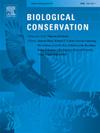在人为改造的热带景观中,影响森林残余物树木再生的多种驱动因素
IF 4.4
1区 环境科学与生态学
Q1 BIODIVERSITY CONSERVATION
引用次数: 0
摘要
森林再生受到一系列复杂的生态过程的影响,其中许多过程日益受到人类活动的影响。然而,关于形成最终树组合的每个过程的相对重要性的信息有限。在这里,我们使用了来自大西洋森林20个森林遗迹的成树和幼树的数据集,测试了一个模型,该模型预测景观尺度的森林覆盖直接或间接地影响了当地耐阴物种幼树的丰度和丰富度。预计这种影响是通过特定局部变化的级联效应发生的,这些变化包括森林垂直结构、成树组合(种子源)的丰度和丰富度、种子传播者的丰度和不耐阴物种的丰度。通过通径分析,我们发现当地耐阴幼树组合的丰度和丰富度受到景观森林覆盖的积极影响。我们还观察到只有幼树丰度通过森林覆盖对成树组合丰度的影响而受到间接影响。这一结果表明,不同的机制对确定热带森林树木多样性指标很重要。此外,我们没有发现森林垂直结构的变化、不耐荫树木的丰度或种子传播者的丰度可以解释耐荫幼种的丰度和丰富度,这表明森林损失引发的其他潜在机制仍有待确定。在目前的情况下,由于再生过程的中断,森林砍伐景观中耐阴组合的多样性可能越来越偏离保护景观的预期。本文章由计算机程序翻译,如有差异,请以英文原文为准。

Multiple drivers shaping tree regeneration in forest remnants within human-modified tropical landscapes
Forest regeneration is shaped by a complex array of ecological processes, many of which are increasingly affected by human activities. However, there is limited information on the relative importance of each process in shaping the resulting tree assemblages. Here, we used a dataset on adult and juvenile trees from twenty forest remnants in the Atlantic Forest, testing a model predicting that landscape-scale forest cover affects the local abundance and richness of juveniles of shade-tolerant species, both directly and indirectly. This influence is expected to occur through cascading effects of specific local changes including forest vertical structure, abundance and richness of adult tree assemblages (seed source), abundance of seed dispersers and abundance of shade-intolerant species. Using path analysis, we detected that local abundance and richness of juvenile shade-tolerant assemblages are positively affected by landscape forest cover. We also observed that only juvenile abundance is indirectly affected by forest cover through its effect on the abundance of the adult tree assemblage. This result demonstrates that distinct mechanisms are important for determining tree diversity metrics in tropical forests. In addition, we found no evidence that changes in the forest vertical structure, the abundance of shade-intolerant trees, or the abundance of seed dispersers explained abundance and richness of juvenile shade-tolerant species, indicating that other underlying mechanisms triggered by forest loss remain to be identified. Under the current scenario, the diversity of shade-tolerant assemblages in deforested landscapes is likely to increasingly diverge from that expected in conserved landscapes, due to disruptions in the regeneration process.
求助全文
通过发布文献求助,成功后即可免费获取论文全文。
去求助
来源期刊

Biological Conservation
环境科学-环境科学
CiteScore
10.20
自引率
3.40%
发文量
295
审稿时长
61 days
期刊介绍:
Biological Conservation is an international leading journal in the discipline of conservation biology. The journal publishes articles spanning a diverse range of fields that contribute to the biological, sociological, and economic dimensions of conservation and natural resource management. The primary aim of Biological Conservation is the publication of high-quality papers that advance the science and practice of conservation, or which demonstrate the application of conservation principles for natural resource management and policy. Therefore it will be of interest to a broad international readership.
 求助内容:
求助内容: 应助结果提醒方式:
应助结果提醒方式:


